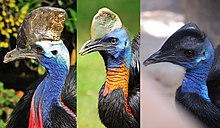
Back شبنم Arabic شبنم ARZ Casuarius AST Narkoyum (Casuarius) AVK Kazuar AZ Kasuari BAN Казуары BE Soari BEW Казуари Bulgarian Kazoar BR
| Cassowary Temporal range: Early Pliocene – Recent
| |
|---|---|

| |
| Montage of three species; left to right: southern cassowary, northern cassowary, and dwarf cassowary | |
| Scientific classification | |
| Domain: | Eukaryota |
| Kingdom: | Animalia |
| Phylum: | Chordata |
| Class: | Aves |
| Infraclass: | Palaeognathae |
| Order: | Casuariiformes |
| Family: | Casuariidae |
| Genus: | Casuarius Brisson, 1760 |
| Type species | |
| Struthio casuarius[1] | |
| Species | |
| |
| Synonyms | |
Cassowaries (Indonesian: kasuari, Biak: man suar 'bird strong',[3][4] Tok Pisin: muruk, Papuan:[citation needed] kasu weri 'horned head'[5] ) are flightless birds of the genus Casuarius, in the order Casuariiformes. They are classified as ratites: flightless birds without a keel on their sternum bones. Cassowaries are native to the tropical forests of New Guinea (Western New Guinea and Papua New Guinea), the Moluccas (Seram and Aru Islands), and northeastern Australia.[6]
Three cassowary species are extant. The most common, the southern cassowary,[7] is the third-tallest and second-heaviest living bird, smaller only than the ostrich and emu. The other two species are represented by the northern cassowary and the dwarf cassowary; the northern cassowary is the most recently discovered and the most threatened.[7] A fourth but extinct species is represented by the pygmy cassowary.
Cassowaries are very wary of humans, but if provoked, they are capable of inflicting serious, even fatal, injuries. They are known to attack both dogs and people. The cassowary has often been labelled "the world's most dangerous bird",[7][8] although in terms of recorded statistics, it pales in comparison to the common ostrich, which is recorded to kill two to three humans per year in South Africa.[9]
- ^ "Cassuaridae". aviansystematics.org. The Trust for Avian Systematics. Retrieved August 5, 2023.
- ^ "Part 7 - Vertebrates". Collection of group names. 2007. Archived from the original on October 5, 2016. Retrieved May 4, 2016.
- ^ F.J.F. Van Hasselt (1947). Noemfoorsch Woordenboek (in Dutch). J.H. De Bussy. p. 146.
- ^ Soeparno (1977). Kamus Bahasa Biak-Indonesia (in Indonesian). Departemen Kebudayaan dan Pendidikan. pp. 39, 71.
- ^ "Interesting facts about Cassowaries". Heritage Lodge. 2021.
- ^ Clements (2007).
- ^ a b c "Cassowary". San Diego Zoo Wildlife Alliance. 2022. Retrieved September 18, 2022.
- ^ Mosbergen, Dominique (April 14, 2019). "'World's Most Dangerous Bird' Kills 75-Year-Old Owner In Florida". HuffPost. Retrieved April 15, 2019.
- ^ Usurelu, Sergiu; Bettencourt, Vanessa; Melo, Gina (2015). "Abdominal trauma by ostrich". Annals of Medicine & Surgery. 4 (1): 41–43. doi:10.1016/j.amsu.2014.12.004. PMC 4323753. PMID 25685344.